mi2jaca
|
| posted on 26/6/19 at 09:18 AM |

|
|
Critique my upright design
Hello,
I wrote a previous thread regarding using bolt-on hubs in an upright design (http://www.locostbuilders.co.uk/forum/3/viewthread.php?tid=215025).
Now its time for the upright to take shape and I thought that I would let the forum have a look and a say. The upper ball joint will be attached from
a bracket to the upright and possibly also incorporate the steering arm or its attachment.
I am trying to make this so that it will fit both sides and so that it will have a minimum of detail for manufacture. Brackets for brake calipers are
not yet included in this design but will probably also be bolt on to the upright.
Right now I am using Austin Maxi ball joints, but are there any other alternatives that might be better, cheaper, more available, future-proof?
Please feel free (relatively  ) to comment. ) to comment.
//Carl
 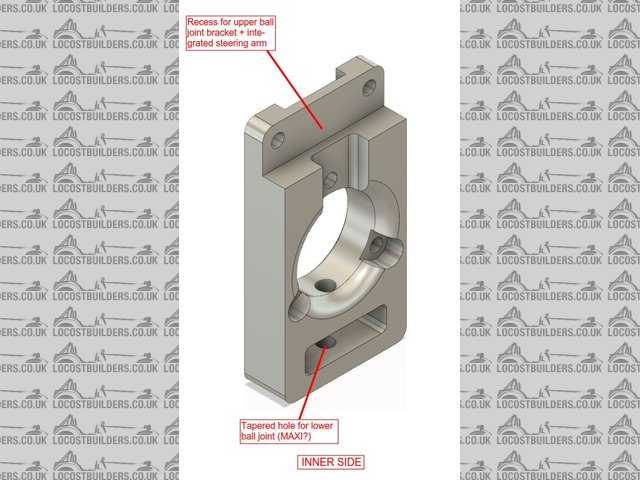
Upright1_rev0 20190626
 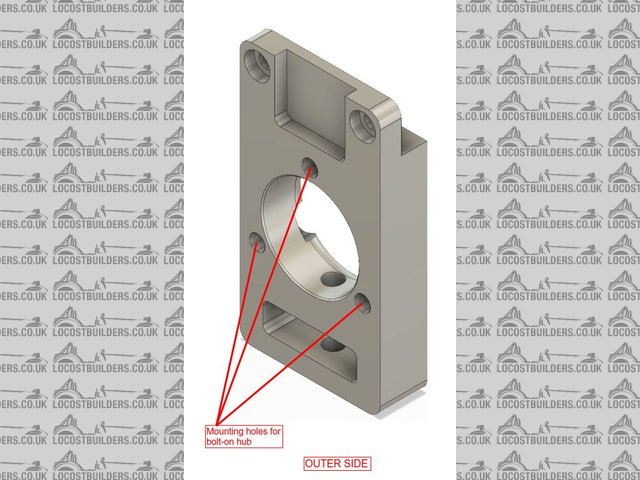
Upright2_rev0 20190626
 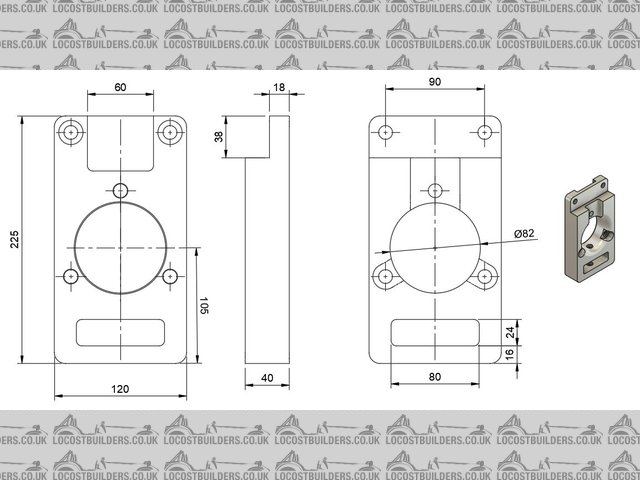
Upright3_rev0 20190626
Edit: Added a sketch of some dimensions
[Edited on 26/6/19 by mi2jaca]
Carl Blomén
Writing from Gothenburg in Sweden
When in doubt - Go fast
|
|
|
|
|
nick205
|
| posted on 26/6/19 at 09:37 AM |

|
|
Do the parts have to meet any specific rules and/or standards qualification for road use?
Is the material steel, Aluminium alloy (or something else)?
|
|
|
coyoteboy
|
| posted on 26/6/19 at 11:39 AM |

|
|
Personally not a fan of bracket attachment for major suspension components - the fewer failure points the better - I know plenty of OEMs do it, but
bolted joints need proper stress analysis just as much as the metalwork does. Do you know your two bolts will have sufficient clamping load to prevent
fastener failure or loosening? Having just had a ball joint failure I'm particularly sensitive to this lol. Your bottom ball joint looks like a
fully captured double-shear rose joint - this i love - will the top be?
It looks pretty chunky even if it's alu, but that may be total overkill with a weight expense you don't need.
What grade of alu (if alu) are you using? Are you using straight alu threads or inserts?
|
|
|
Mr Whippy
|
| posted on 26/6/19 at 12:02 PM |

|
|
but why? when there are alternatives to use, I can't really see the benefit
For example MK Sports cars have -
Sierra ones for just £120 a pair
Alloy Cortina ones for £360 a pair
Sierra billet alloy ones for £550 a pair
Unless you can machine them yourself those must surely be cheaper options?
linky
|
|
|
motivforz
|
| posted on 26/6/19 at 12:41 PM |

|
|
First thing that jumps out are those sharp internal corners - these are stress raisers and if made out of Aluminium (no endurance limit in fatigue)
then they're going to crack eventually. A nice 3mm radius minimum should be targeted using a 6mm ball nose cutter.
The external rad on the central bore will be difficult to machine (unless being turned?), so a chamfer may be easier if acceptable?
Otherwise can't say without loads whether it'll be ok or not - that'll have to be up to you to determine.
Hope that helps - certainly not meant to be negative!
|
|
|
coyoteboy
|
| posted on 26/6/19 at 12:53 PM |

|
|
quote:
Originally posted by Mr Whippy
but why? when there are alternatives to use, I can't really see the benefit
For example MK Sports cars have -
Sierra ones for just £120 a pair
Alloy Cortina ones for £360 a pair
Sierra billet alloy ones for £550 a pair
Unless you can machine them yourself those must surely be cheaper options?
linky
I'm guessing that if he's not looking at the normal options, there's a reason. Either he wants to do the design for the experience,
or he wants to do something strange. Pretty sure no-one goes into a suspension design task without first reviewing the off the shelf options?
Re external rad - standard corner rounding cutter? 2.5D milling with ball? Maybe I'm looking at "hard" from a different perspective
but neither of those looks like a difficult option in my mind (though the rad is large).
[Edited on 26/6/19 by coyoteboy]
|
|
|
bozla
|
| posted on 26/6/19 at 01:28 PM |

|
|
Good point is that you can adjust the kpi with spacers. But as others have pointed out, you can get great parts a very reasonable price. There are
only 2 reasons I can think of for making your own. 1) you can't get the geometry you want from an off the shelf component, 2)weight
reduction.
Rally design offer one (all ali) with hubs, discs, willwood calipers for about 500+tax for a pair. They also go with their locost wishbones or the
longer westfield ones.
I have made my own however as I wanted m/c discs and calipers with 7deg kpi and 7deg caster. Gutted I couldn't get one off the shelf at
reasonable cost.
Drd racing do a ali hub (can take both 108 & 4inch pcd) and weld in stub axle (vauxhall viva based) if you want to go down this route. Rally
design offer ali hubs and bolt on stub axle as well (Cortina based). Drd can even make the uprights to your geometry - in hindsight, would have been
better in my case. The PRS, which was dominating the 750 formula last year, has drd fabbed uprights.
[Edited on 26/6/19 by bozla]
[Edited on 26/6/19 by bozla]
|
|
|
Mr Whippy
|
| posted on 26/6/19 at 01:41 PM |

|
|
Kind of looks very normal/ish tbh
Although quite heavy... that top flange with the sharp internal corner looks a fatigue point at an area of high load. I'd put a nice big radius
there as a minimum. But I'm not very keen on the bracket idea anyway.
Have caster and camber angles been taken into account and how does the steering arm attach? You say you want to keep them symmetrical but that means
the bracket will have to accommodate all the geometry. Plus it is normal for the lower ball joint to be ahead of the hub centre to help induce caster,
with the upper ball joint trailing.
With the steering arm mounted at the top that means the steering rack will have to be mounted high on the chassis, is there room?
It would be easier to critique it if we saw the whole design including the wishbones and chassis mounting and steering system. You'll also have
to match the brake caliper location on the hub with the mounting flange on the upright which means you'll need to model the whole thing...
Personally I'd opt for a modern single piston floating caliper and use the carrier they come with then bolt that to the upright, will make life
a lot easier. I'd also recommend not using rose joints unless it's for track use only.
[Edited on 26/6/19 by Mr Whippy]
|
|
|
talkingshte
|
| posted on 26/6/19 at 04:37 PM |

|
|
How about S1 elise uprights? or TVR tuscan fronts are lightweight too.
|
|
|
gremlin1234
|
| posted on 26/6/19 at 05:04 PM |

|
|
looks to me that accessing the nut on the lower ball joint would be difficult at best.
as others have said, 'why try to reinvent the wheel? '
|
|
|
mi2jaca
|
| posted on 27/6/19 at 07:36 AM |

|
|
Thanks for the feedback people!
Some quick answers to your questions:
• No real rules or standard to fulfill but will need to show some form of calculations
• Will be milled from AW-7075 aluminium
• First iteration might look a little chunky – will hopefully shave some weight off
• Threaded inserts sound like a nice idea
• “But why?” was not a question so I’m not going to go into that
• I am not actually that concerned about sharp edges – stresses will be calculated for
• I am aming for a geometry with KPI of 8 deg, caster of 5 deg and a scrub radius of 12 mm
• It’s for a single seat lightweight locost
• Steering arm is still WIP
• Total package is also still WIP – perhaps another thread for that?
• S1 Elise uprights – they cost a fortune right?
• No problems accessing the nut on the lower ball joint
Hope that answers some of your questions.
Once again thank you for your interest, its always nice to get a second opinion.
Carl Blomén
Writing from Gothenburg in Sweden
When in doubt - Go fast
|
|
|
nick205
|
| posted on 27/6/19 at 08:04 AM |

|
|
Lotus Elise S1 front uprights
(I'm asking because I don't know)
Are they custom designed and manufactured components or are they components selected from an existing (at that time) vehicle?
|
|
|
mi2jaca
|
| posted on 27/6/19 at 08:17 AM |

|
|
quote:
Originally posted by nick205
Lotus Elise S1 front uprights
(I'm asking because I don't know)
Are they custom designed and manufactured components or are they components selected from an existing (at that time) vehicle?
I believe they are Lotus own design and manufacture
[Edited on 27/6/19 by mi2jaca]
Carl Blomén
Writing from Gothenburg in Sweden
When in doubt - Go fast
|
|
|
coyoteboy
|
| posted on 27/6/19 at 08:51 AM |

|
|
** I am not actually that concerned about sharp edges – stresses will be calculated for
So long as you're on top of your SN curves 
|
|
|
mi2jaca
|
| posted on 27/6/19 at 09:10 AM |

|
|
quote:
Originally posted by coyoteboy
** I am not actually that concerned about sharp edges – stresses will be calculated for
So long as you're on top of your SN curves 
I am looking at 150 MPa for 500 000 000 (!) full load cycles. Sounds about right?
Carl Blomén
Writing from Gothenburg in Sweden
When in doubt - Go fast
|
|
|
hughpinder
|
| posted on 28/6/19 at 10:57 AM |

|
|
Elise mk2 uprights for inspiration, which are also used on the VX220:
https://www.sjsportscars.com/parts-and-accessories/A116C0001F.htm plus
https://www.sjsportscars.com/parts-and-accessories/SJ117D0004.htm
Regards
Hugh
|
|
|
Grimsdale
|
| posted on 28/6/19 at 11:29 AM |

|
|
I'm not a mechanical engineer, so i'll stick to the areas i know about.
My main issue is material selection. 7075 is highly susceptible to stress corrosion cracking (SCC), along with other copper containing aluminium
alloys.
Stress corrosion cracking is a failure mechanism where a material under load in a corrosive environment cracks fairly rapidly. If you're not
familiar with it, have a read up here: http://www.totalmateria.com/Article17.htm
"Alloys 7079-T6, 7075 –T6 and 2024 – T3 contributed to more than 90% of the service failures of all high-strength aluminum alloys."
Alloy 6082 is much more commonly used in automotive components as it is quite resistant to SCC.
Andy
|
|
|
coyoteboy
|
| posted on 29/6/19 at 09:28 AM |

|
|
6082 does have a huge specific strength penalty though, I guess it depends on whether a race vehicle will see significant corrosive environment. And
whether he plans to heat treat after machining or before?
SCC isn't in my day to day, I'd be interested to see some of the automotive failures if you have any links to study?
|
|
|
talkingshte
|
| posted on 29/6/19 at 09:28 PM |

|
|
elise parts do second hand ones sometimes, or improved std ones or totally sexy gt ones. You could always find used ones off a scrapper. Think
they're about 1500 all in from memory. inc hubs and bearings...
Correct me if I'm wrong but S2 elise uprights are steel and s1 are ali?
[Edited on 29/6/19 by talkingshte]
|
|
|
coyoteboy
|
| posted on 30/6/19 at 11:41 AM |

|
|
When I was searching a few years ago, the s1 ones were coming in around 1500 a set without bearings. Cleaned up but used.
|
|
|
mi2jaca
|
| posted on 1/7/19 at 06:51 AM |

|
|
I will have to look into the material selection and SCC. Can proper surface treatment help? Anodizing?
Elise parts do sound expensive.
Made a quick sketch of an upper bracket with steering arm to get an idea of the concept. This feels like it’s too much bracket but it’s a starting
point.
 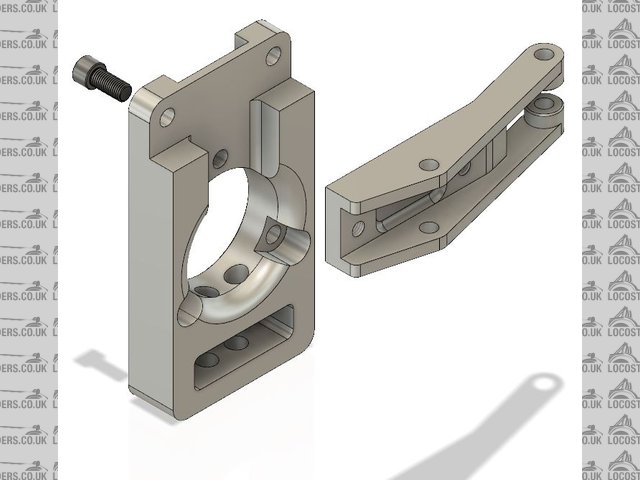
Upright_rev1_20190628
Carl Blomén
Writing from Gothenburg in Sweden
When in doubt - Go fast
|
|
|
JAG
|
| posted on 1/7/19 at 08:22 AM |

|
|
quote:
I am looking at 150 MPa for 500 000 000 (!) full load cycles. Sounds about right?
150 Mpa - is a vehicle related load. You're better placed to know if this is correct or not.
Is this a vertical load or lateral load?
Does it represent a one off abnormal load? like a kerb strike or pothole impact? or is it an everyday load? like a 0.2g lateral acceleration?
Then you're going to assume that load is applied for 500,000,000 cycles?
That looks like 1/2 a Billion cycles? That's way more than I would expect.
I work for a Car Manufacturer in Chassis Design and we'd expect a 10 year vehicle life to be around 5 Million cycles or 5,000,000.
Justin
Who is this super hero? Sarge? ...No.
Rosemary, the telephone operator? ...No.
Penry, the mild-mannered janitor? ...Could be!
|
|
|
mi2jaca
|
| posted on 1/7/19 at 08:53 AM |

|
|
quote:
Originally posted by JAG
quote:
I am looking at 150 MPa for 500 000 000 (!) full load cycles. Sounds about right?
150 Mpa - is a vehicle related load. You're better placed to know if this is correct or not.
Is this a vertical load or lateral load?
Does it represent a one off abnormal load? like a kerb strike or pothole impact? or is it an everyday load? like a 0.2g lateral acceleration?
Then you're going to assume that load is applied for 500,000,000 cycles?
That looks like 1/2 a Billion cycles? That's way more than I would expect.
I work for a Car Manufacturer in Chassis Design and we'd expect a 10 year vehicle life to be around 5 Million cycles or 5,000,000.
150 MPa is a material mechanical property and is not vehicle load related. It is from Matweb and a standard RR Moore test and is valid for 5.00e+8
full load cycles. That’s a lot of cycles, yes! I don’t expect anyway near that many cycles.
I have yet to check the actual stresses in the upright for the loads you mention but I expect them to be lower than 150 MPa. Will see if I can show
some short hand calculations to make initial checks.
Carl Blomén
Writing from Gothenburg in Sweden
When in doubt - Go fast
|
|
|
coyoteboy
|
| posted on 1/7/19 at 06:26 PM |

|
|
quote:
Originally posted by JAG
I work for a Car Manufacturer in Chassis Design and we'd expect a 10 year vehicle life to be around 5 Million cycles or 5,000,000.
I'm inclined to agree in general, but 5 million cycles of what - nominal full travel vertical forces, max cornering load, worst case load? Some
mean value from test data? If you're looking at. 5e6 cycles the sn curve is pretty flat between e6 and e8 anyway, maybe 10mpa in it.
|
|
|
mi2jaca
|
| posted on 2/7/19 at 06:38 AM |

|
|
If you make at a very(!) simple calculation of a section of the upright it might look something like this:
The cross-section shown below is 1560 mm2 (120x18-10x60 mm)
 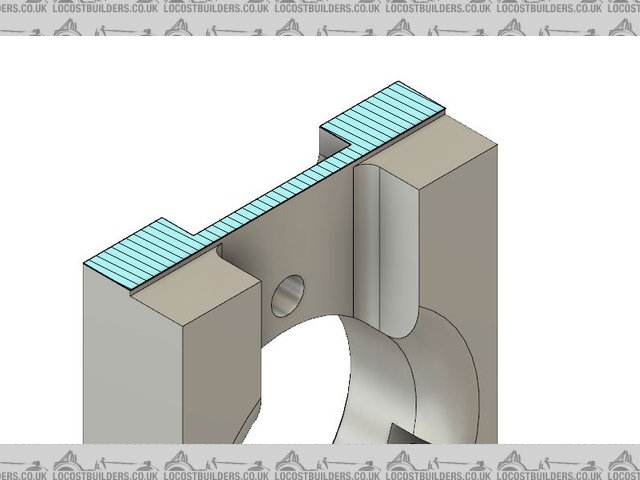
Upright1_rev1_cut
If we assume that we can load this to a stress level of 150 MPa then that is 150 N/mm2: 1560x150 = 234 000 N
234 kN divided by 9,81 equals 23853 kg and that is equal to a fairly large excavator
 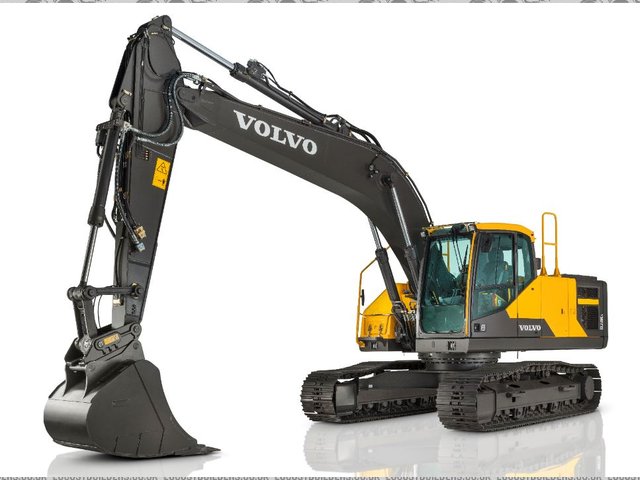
EC220
That is in pure tensile load and should not be used as a design figure by any means!
Just doing a small correction for shear and using von Mises gives a factor of 0,577 = 13763 kg which is a much smaller excavator
Take all this with a grain of salt, its just me playing with some numbers.
Carl Blomén
Writing from Gothenburg in Sweden
When in doubt - Go fast
|
|
|













